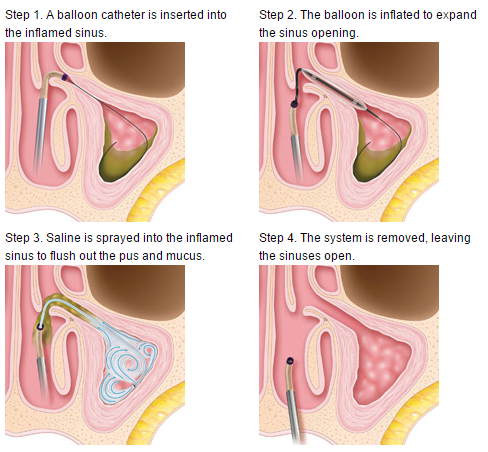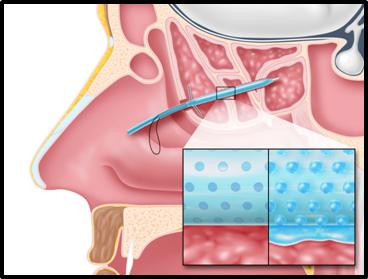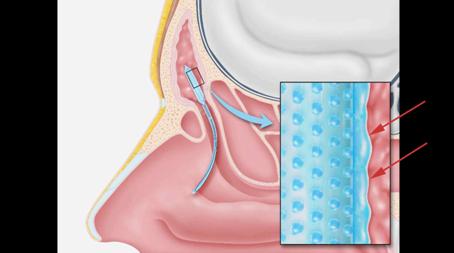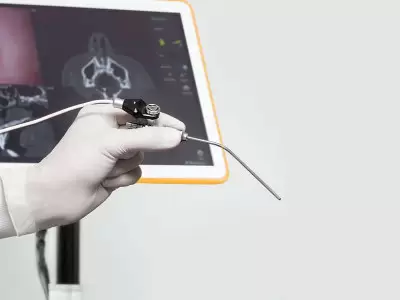Balloon Sinuplasty
In recent years, especially as a consequence of the advances in the field of medical technology, technologies and devices that increase the success rate of the surgery and result in fewer traumas and also significantly decreasing the complication risk are introduced in the surgical treatment of chronic sinusitis. The most important ones among these technological advances are called balloon sinuplasty and surgical navigation. Both technologies may be used safely following the procurence of the necessary training and experience directed to their uses.
What is Balloon Sinuplasty?
Balloon sinuplasty is enlargement of the blocked or narrowed drainage channels of the sinuses with the help of a balloon, without excising and removing a tissue and reestablishing of the functions (Figure 1).
 Figure 1. Stages of balloon synoplasty
Figure 1. Stages of balloon synoplasty
What are the advantages of balloon synoplasty ?
It is an effective and safe method. Complication rate is very small and the drainage channels (ostiums) widened by the balloon are observed to be 98% open at the end of 2 years .
Minimal invasive: small, soft, elastic equipments are used in the technique, the closed drainage channels are gently opened and the results may be obtained with so little tissue trauma.
Decreased bleeding: since tissue removal is not required in some cases, bleeding is very less.
Rapid recovery: most of the patients return back to their normal lives within 24 hours.
It does not interfere with other treatments that may be applied to the same region in the future. May be performed simultaneously or consecutively with other surgeries.
Is balloon technique a solution to all sinusitis?
Balloon technique is a novel and auxiliary technique that can not take the place of sinusitis surgery. When this technique was started to be used for the first time, it could only be used for the forehead, cheeks and sphenoid (the backmost sinus in the head) due to the properties of the present equipment, however recently, equipment that can intervene the ethmoid sinuses with balloon synoplasty have been developed (Figure 2). With the help of balloon catheters with reservoirs that are placed in the ethmoid sinuses, these sinuses are reached and endosinusial drug administration can be performed. Today, the use of synoplasty is limited in nasal polyps and balloon technique combined with classical endoscopic surgery in these cases.
 Figure 2. Synoplasty catheter with drug reservoir applied to ethmoid sinuses
Figure 2. Synoplasty catheter with drug reservoir applied to ethmoid sinuses
Is balloon technique safe?
No major complication has been reported until now. Patients’ being exposed to X-rays due to the usage of scopy device during the operation in order to provide the appropriate placement of balloon catheters in the sinus channels was considered to be the biggest drawback of this technique. Development of guidance wires with light in order to eliminate this problem, the sinuses of the cheek and the forehead may be reached without the use of scopy, therefore this problem was solved to a large extent. Today, scopy device is only used when intervening the sphenoid sinuses and since necessary adjustments are made and since the duration of the operation is quiet short when performed by an experienced specialist by using an appropriate technique, the X-ray amount that the patient is exposed to is provided to be very less.
Stents with reservoir for the sinuses of the forehead
One of the most important benefits of balloon synoplasty technology is the development of stents with steroid reservoirs that are used in the sinuses of the forehead (frontal sinus).
Discharge chandelles of the frontal sinus are located in hard bone structures unlike other sinuses and may be quiet narrow depending on the anatomical structure. Due to their placements, following-up of frontal sinuses after the operation is very difficult and after the interventions of frontal sinuses, blocking of the narrow channels by recovery tissue, edema and dried secretions may lead to the recurrence of the disease the recovery tissue of these narrow channels. Frontal sinus stents with reservoirs, a part of the balloon synoplasty technique are placed into the sinus from the frontal sinus discharge channels that are opened or enlarged during the surgery an slowly release the steroid found in the reservoir for a period of two weeks and prevent the blocking of the sinus mouth again (Figure 3).
Frontal sinus stents may either be placed from the enlarged frontal sinus channel or may be placed by the sinus channel that is opened during the surgery without the application of balloon enlargement to prevent the blockage of this region during recovery in cases where frontal sinuses are intervened with endoscopic sinus surgery. Frontal sinus stents may easily be removed in a polyclinic environment during the dressings that are applied with 2-3 week intervals after the surgery.
 Figure 3.Ballon stent with drug reservoir placed into the frontal sinus
Figure 3.Ballon stent with drug reservoir placed into the frontal sinus






Comment
Your Contact Information will not be shared in any way. * Required Fields